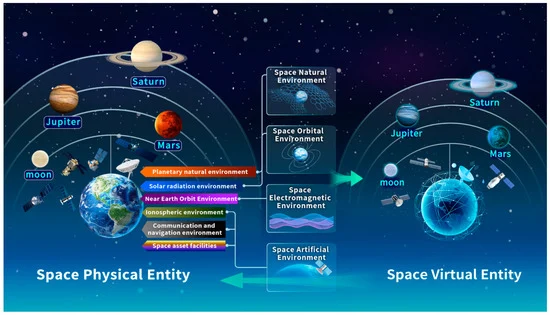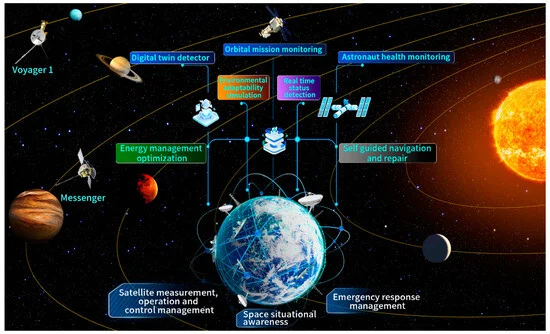Unlocking Product Development in the NewSpace Economy
The NewSpace economy is booming. With private companies driving space exploration and commercialization at an unprecedented pace, the industry is more innovative and fast-moving than ever. But success in this new frontier comes with a big challenge: how do you design, test, and operate complex space systems while keeping up with the breakneck speed of innovation?

Let’s explore how digital twins and MBSE are reshaping product development in the NewSpace era—and why they’re critical to the future of space exploration.
What Are Digital Twins, and Why Are They So Powerful?
At its core, a digital twin is more than just a 3D model of a satellite or spacecraft—it’s a living, breathing virtual replica, a live model. It takes real-world data, like telemetry as well as environmental inputs, and uses it to create a constantly updated simulation of the physical system. This allows engineers to monitor, analyse, and optimize a space system across its entire lifecycle—from the initial design all the way through to its eventual disposal.
In the fast-paced NewSpace economy, digital twins redefine what’s possible. Digital twin technology in space has to consider the natural, orbital, electromagnetic, and artificial environments specific to space. They enable virtual product lifecycles, which means that instead of relying solely on physical prototypes and testing, companies can iterate, test, and improve designs in a virtual synthetic environment. This drastically reduces the time, cost, and risk of bringing new space technologies to market.
The Role of SE and MBSE in Unlocking Potential
Engineers use MBSE to create detailed, system-wide models of space assets in the early stages of development. These models help optimize designs for performance, reliability, and cost. Digital twins take things a step further. By integrating real-world data, they enable simulations that account for uncertainties like thermal stress, micrometeoroid impacts, or fuel boil-off.
Smarter Design and Simulation
With digital twin technology, mission planners are now able to comprehensively rehearse and evaluate missions in a virtual environment, optimizing both resources and risk management strategies. By simulating critical phases—such as launch window selection, orbital insertion, scientific operations, and return to Earth—digital twins are helping identify potential risk points and improve mission feasibility and safety.
Imagine designing a satellite and being able to predict how it will perform in orbit before a single component is built or acquired. That’s the power of combining MBSE with digital twins.
Better Integration and Validation
Virtual prototypes make it possible to test how different subsystems will interact without needing to build physical hardware. Common integration challenges—like ensuring that a satellite’s payload communicates properly with a ground station—can be resolved virtually, reducing last-minute surprises.
By catching problems early and iteratively testing solutions in the virtual world, teams save both time and money.
Real-Time Optimization During Operations
Satellites equipped with digital twins can also send real-time data back to Earth, allowing engineers to make smarter decisions about maintenance and performance. This real-time feedback loop is especially valuable in space, where every resource counts and quick decision-making can mean the difference between mission success and failure.
For example, satellites in low-Earth orbit (LEO) constellations can use digital twins to predict and avoid collisions while conserving precious fuel.
Supporting End-of-Life Planning
When space assets reach the end of their lives, digital twins can help engineers plan deorbit manoeuvres or even find ways to repurpose the technology. This helps minimize space debris and aligns with growing global efforts to make space exploration more sustainable.
MBSE: The Secret to Unlocking the Power of Digital Twins
MBSE is the glue that holds it all together. It provides the framework for creating comprehensive system models that ensure every piece of the puzzle—from mission requirements to design changes—is accounted for.
Key Benefits of MBSE in the NewSpace Economy:
- ● Unified Views: Teams from different disciplines can work off a single, shared model, reducing miscommunication and ensuring alignment.
- ● Automation and Agility: MBSE helps track and resolve unresolved issues (a.k.a. technical debt) in real-time, preventing them from snowballing into bigger problems.
- ● Managing Technical Debt: Repetitive tasks are an inherent part of systems engineering, but they can consume valuable time. AI excels at managing these tasks with accuracy and speed. This frees up engineers to focus on the bigger picture – strategizing, innovating, and optimizing the system’s design. It is like giving them extra brainpower to work more efficiently!
Together, MBSE and digital twins enable a seamless, iterative approach to product development that aligns with the rapid pace of the NewSpace economy.

Overcoming Challenges: What Needs to Be Addressed?
While digital twins and MBSE are transformative, implementing them at scale does come with challenges. Here are some hurdles the space industry must address:
- ● Data Management: Simulating real-world conditions requires massive amounts of data. MBSE helps by standardizing inputs and outputs across teams.
- ● Model Accuracy: Digital twins must remain precise over time. Rigorous validation and verification processes are essential to reduce errors.
- ● Real-Time Synchronization: Space missions especially those in deep space face unique communication delays. Edge computing and autonomous algorithms can help digital twins process critical data locally, reducing dependence on Earth-based control centres.
The Broader Impact on the NewSpace Economy
The fusion of digital twins and MBSE isn’t just a technical upgrade—it’s a strategic shift that could reshape the future of space exploration. Here’s why it matters:
- ● Accelerating Innovation: Virtual development and testing allows companies to iterate and improve designs faster, enabling startups and established players alike to stay competitive.
- ● Boosting Reliability: AI-powered digital twins can predict and prevent failures, improving safety and performance.
- ● Autonomous Operations: Digital twins are starting to enable spacecraft to self-manage, and in the future, we’ll see fully autonomous missions to deep-space destinations.
- ● Collaborative Space Infrastructure: The space industry is moving toward a future where satellites, space stations, and vehicles seamlessly work together in shared orbits, enabled by unified digital models.
- ● Democratizing Space: Lower costs and faster development times are already reducing barriers to entry, and this trend will continue driving innovation and accessibility for new players in the space industry.
A great example of this in action is SpaceX’s Starship program, which uses digital twins and MBSE to simulate everything from launch dynamics to interplanetary landings. By linking mission requirements with system designs, they’re able to address complex challenges, like launching from Mars, with greater precision and confidence.
The NewSpace economy is transforming how we explore and use space, and this shift is happening right now. Digital twins and MBSE are at the forefront of this change, enabling smarter design, faster iteration, and greater sustainability. These tools aren’t just theoretical—they’re already being implemented, and their influence will only grow in the coming years.
If you’re working in the space industry, the time to embrace these technologies is now. The companies that adopt MBSE and digital twins today will be the ones leading the charge into a more innovative, efficient, and sustainable future in space.
Let’s build the future of space physically and digitally, one virtual iteration at a time.
References
- Liu, W., Wu, M., Wan, G., & Xu, M. (2024). Digital Twin of Space Environment: Development, Challenges, Applications, and Future Outlook. Remote Sensing, 16(16), 3023.
If you are interested in understanding how to adopt systems engineering and model based systems engineering practices within your organization, reach out to BlueKei Solutions team at info@Blue-Kei.com. We specialize in systems engineering consulting, project executions, process adoptions such as compliance to ISO15288, ARP 4754A, ISO 42020, digital transformations. We can also conduct capability development workshops which are experiential and tailored to your needs. With systems engineering adoption you can address the complexity, manage evolving risks and bring transformation in communication within your organization through digitalization and create the digital thread.

